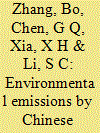|
|
|
Sort Order |
|
|
|
Items / Page
|
|
|
|
|
|
|
| Srl | Item |
| 1 |
ID:
171419


|
|
|
|
|
| Summary/Abstract |
Aiming at the bi-level multi-objective characteristic of the energy-environment-economy(3E) system of China, this paper constructed a bi-level multi-objective optimization model. Six scenarios were simulated in preference to energy saving, emission reduction and economic development. And energy consumption, carbon emission and economic development were analyzed in different scenarios during the 13th five-year plan (2016–2020). The following results were obtained: during the 13th five-year plan, the national targets of energy consumption, carbon emission and economic development are easily achievable. However, it is hard for most regions to achieve their energy conservation and emission reduction (ECER) targets when accomplishing their own economic targets. In other words, regional economic targets mismatch their ECER targets. The effects of ECER are not ideal in the energy saving scenario and the carbon emission reduction scenario, while they are relatively satisfactory in the economic development scenario. The “win-win” situation between upper-level and lower-level is realizable in the economic development scenario, i.e., high-quality economic development may germinate good effects on ECER.
|
|
|
|
|
|
|
|
|
|
|
|
|
|
|
|
| 2 |
ID:
113460


|
|
|
|
|
| Publication |
2012.
|
| Summary/Abstract |
Based on chemical exergy as an objective measure for the chemical deviation between the emission and the environment, a unifying assessment is carried out for major environmental emissions covering COD, ammonia nitrogen, SO2, soot, dust, NOx and solid waste by Chinese industry over 1997-2006, with emphasis on the sectoral and regional levels in 2006. Of the total emission in exergy up to 274.1 PJ in 2006, 67.7% is estimated from waste gases, 29.9% from waste water and 2.4% from solid waste. Five of 40 sectors and 12 of 30 regions are responsible for 72.7% and 65.5% of the total emission, respectively. SO2 is the leading emission type in 9 sectors and 25 regions, and COD in another 28 sectors and 5 regions. Some pollution-intensive sectors such as Production and Distribution of Electric Power and Heat Power and Manufacture of Paper and Paper Products, and western and inland regions such as Guangxi and Ningxia with high emission intensities are identified. By clustering and disjoint principal component analysis with intensities of emissions and fuel coal use as variables, three principal components are extracted, and four statistically significant clusters are pinpointed in the sectoral and regional analysis. Corresponding policy-making implications are addressed.
|
|
|
|
|
|
|
|
|
|
|
|
|
|
|
|
|
|
|
|
|